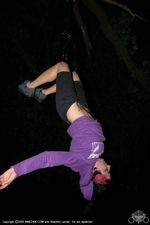Knee Suspension
During a knee suspension, the body is inverted, and the knees are bent. This style is relatively new, but is quickly growing in popularity. Knee suspension is often shocking for spectators, as people think it looks painful. As it is, once you are in the air, it is actually one of the more comfortable suspensions, providing you can get used to being upside-down.
Contents |
Placement
One, two, or three hooks are placed in each knee. For a 6 hook suspension, hooks are placed either side of the kneecaps, and one slightly up from the top of the kneecap. For a 4 hook placement, only the side hooks are used. For a two hook suspension, only the upper hooks are used. It is possible to place hooks below the kneecap, but this tends to be much less comfortable.
Risks
As the skin on the sides of the knees is fairly thin, ripping sometimes occurs. Usually, the suspendee can feel the skin starting to rip and will come down immediately, leaving a small tear that takes a couple of sutures to close. In very rare cases, it is possible for the hook to rip out of the skin, causing the person to drop. For this reason, it is sensible to wear a safety harness as a back-up during high suspensions. Other drawbacks include lower back pain and increased blood pressure to the brain due to the inverted position, which can lead to disorientation and cause headaches.
Trivia
Many people refer to this as a "Falkner" suspension since Allen Falkner is the first known person to ever attempt this particular configuration.


